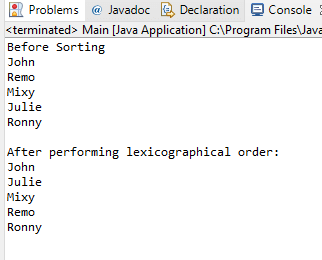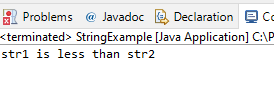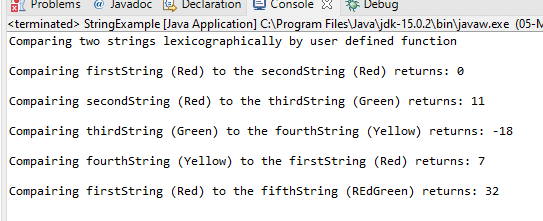Lexicographical Order JavaThe term Lexicographical order is a mathematical term known by names: lexical order, lexicographic(al) product, alphabetical order, or dictionary order. This section will cover the topic lexicographical order, its definition, and other detailed information. After that, we will learn how to use the concept of lexicographical order in the Java programming language. Defining Lexicographical OrderLexicographical order or lexicographic in mathematics is a generalization of the alphabetical sequence of the dictionaries to the sequences of the ordered symbols or elements of a totally ordered list. The term lexicographical order is motivated by the word 'lexicon'. Lexicon is the set of words used in some of the other languages and has a conventional ordering. Thus, lexicographical order is a way for formalizing word order where the order of the underlying symbols is given. In programming, lexicographical order is popularly known as Dictionary order and is used to sort a string array, compare two strings, or sorting array elements. It becomes quite easy to sort elements lexically. It is because lexicographical order has several variants and generalizations in which:
Understanding the Formal Notion of Lexicographical Order
Implementing Lexicographical in JavaAs discussed above that lexicographical order can be used either for comparing two strings or sorting the elements. Here, we will discuss both the methods and will Implement each. Sorting Elements in Lexicographical Order Arranging words in order is known as lexicographical order or also known as Dictionary order. It means that on applying lexicographical order, the words are ordered alphabetically as per their component alphabets. For sorting a string array in lexicographical order, we have the following two methods: Method 1: Applying any sorting method Below is the example code given that will let us understand that how we can perform sorting on elements in Lexicographical order: Code Explanation: In the above code, we have created a class Main within which the main () method is created.
On executing the above example code, we got the following output: 
From the output, we can analyze that the given sequence of the words was not in alphabetical order but after applying the lexicographical order code, we can see that every word is sequenced now in alphabetical order. Method 2: Applying sort () function The sort () method is available in the Arrays class within the util package. Below is the example code given that will let us understand that how we can perform sorting on elements in Lexicographical order: On executing the above output, we got the below-shown output: 
Comparing two strings using Lexicographical order in JavaFor comparing two strings using Lexicographical order, we have the following two methods: Using compareTo () method Let's begin one by one: Using compareTo () method Below is an example implementation by which we can compare to strings lexicographically: Code Explanation:
Output: 
By creating a user-defined function Below we have created a user-defined function using which we can compare two strings lexicographically. The code is as follows: Output: 
Code Explanation:
Therefore, in this way, we can make use of the lexicographical order in Java for performing such tasks.
Next TopicAdam Number in Java
|
 For Videos Join Our Youtube Channel: Join Now
For Videos Join Our Youtube Channel: Join Now
Feedback
- Send your Feedback to [email protected]
Help Others, Please Share










